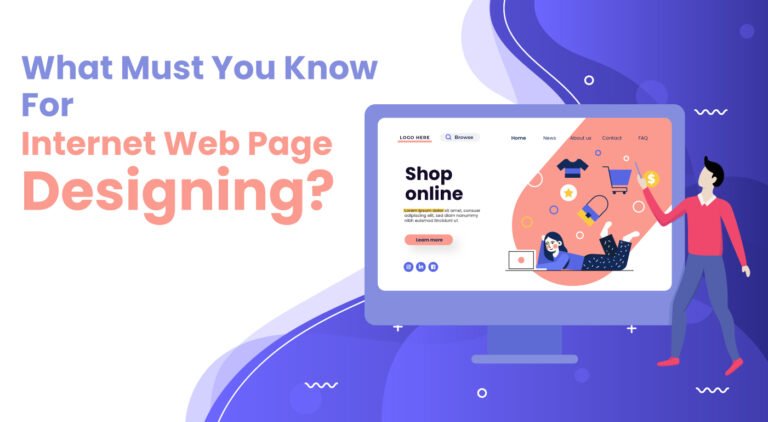25 May, 2022 | web page design
What Must You Know For Internet Web Page Designing?

Dynamic vs static:
It would be best if you decided whether you are looking for static solutions or dynamic ones. Graphic designers can be considered as the one source that fulfils the media requirement of web designers. But, it's not the only application of graphics. Graphic designers are equally needed in print media as well as in marketing agencies. To make your product sell in the market, you need to blend it with creativity. Graphics are known to attract the attention of people more than the textual content, and that's why designing plays a vital role in the market. When a web designer is creating a web page design layout, they need to be extra cautious about all the "users" and "visitors". They have to think about the design experience of every individual. In contrast, graphic designers keep a more generic division of "viewers". Different groups of viewers may have a different understanding of the media elements shared. Still, there is no change in the experience of perceiving them. Web designers work precisely on each of the design elements to improve the performance of the user across different platforms and different devices. Web designing is dynamic, and graphic designing can be static as well as dynamic, depending upon your end-goal. To work on the functionality of your site, you must have web designers on board. For the requirement of graphics, you can web designers work closely to share the requirements and get the best of the result.Optimization of performance:
Web designers are dedicated to working on UI/UX designing of the web page. Thus, the optimization of design and design attributes is significantly crucial for them. Graphic designers are not so concerned about the image size and formats unless otherwise stated. But, web designers need to be cautious about:Image format:
A user can visit the website from any device and any of the available browsers. You need to follow standard image formats like .jpeg, .png, .webp to offer a similar experience to all the users across all the browsers. If you use the image formats that are acceptable on one of the browsers but not on the other, you will suffer from the lossy experience of visitors.Size of media elements:
The standard size of images for each of the web pages on the site is decided to maintain uniformity across the theme. Web designers have to keep an eye on the dimension as well as the file size of the media elements embedded on the site. Since the file size directly impacts the loading speed of the site, it's to be taken care of during web optimization.Font style:
Typography is an indispensable part of web designing. When counting on other media elements, font style is something that needs the same attention. In the graphics, there will not be a change in visual experience. Still, when you are using the content on the website, it may or may not be displayed in the same fashion. The reason being all the fonts are not supported across the browsers. That's why the compatibility check is a must before updating any new fonts for the different sections of your website.Accessibility features:
Your website is designed in the same way for all the users, be it from any country or caste or creed and even for people with disabilities. To offer the same experience, accessibility features like keyboard friendliness, colour schemes (light and dark versions of the same website), user forms, language change, resizable text, and navigation are a must. These will refine the customer experience.CSS scripting & responsiveness:
Web designers can't only think about the media elements, but they have the challenge of maintaining the responsiveness of your entire site. Tweaking the design as per the layout and CSS tricks help you refine user experience with an intuitive user interface.Feed your consistent designing requirements:
For graphics and media elements, you will be done with single-time designing. You may need help from a professional graphic designer for once in a while or when you want to redesign. But, you will consistently need a web designer's assistance to update the web page design layout. When the industry standards are changing at a fast pace, what's working today may not be working tomorrow. With the help of user data that you've acquired from Analytics of your site and visual data tools, you can understand the customer interaction pattern on your website. Leveraging all this data, web designers can help you with different options of the web page design layout. They will update the CTAs, typography, design elements, and even the graphics to be added or removed from your website. The goal behind these changes is not only the improvement of user experience, rather optimize the conversion rate of your website. Walking with the trends and experimenting with these ideas can make your website more functional and improve the relationship with the audience. When you are building from scratch, web designers follow industry standards only. You can enquire about your users about their experience with your business. Based on the timely survey and regular feedback, you can listen to the views of your website visitors. Some of the ideas can be realized to reality and bring profitable results for your business. There are endless possibilities to improve the web page design for your site. Considering your project requirements, you can think about the additions you like to make and the role each one of the individuals in the team will play. If you have the web development project in your hand or looking website redesigning services, you can write to us at sales@www.wedowebapps.co.uk. also read more about I Need a Website DesignerFrequently Asked Questions
The essential technical skills required for internet web page designing include knowledge of HTML, CSS, JavaScript, and web design software such as Adobe Photoshop or Sketch. Additionally, understanding of responsive design, UX/UI design, and accessibility guidelines are important for creating user-friendly and visually appealing websites. It's also important to have knowledge of various programming languages such as PHP or Ruby on Rails, as well as familiarity with content management systems (CMS) such as WordPress or Drupal. Keep in mind that web design is a constantly evolving field, so staying up-to-date with new technologies and trends is crucial for success.
Web page designers must ensure that their web pages are search engine optimized (SEO) to improve visibility and traffic. One way to do this is by using relevant keywords in the title and meta descriptions of the page. Including headings and subheadings and making sure they include relevant keywords can also help. Additionally, designers should ensure that the website's URL structure is SEO-friendly, with clear and readable URLs. Web pages should also have high-quality content that is informative and engaging. Finally, web designers need to make sure their website's load time is quick, as search engines prioritize fast-loading websites. There are many other factors to consider, so web designers may need to invest time in research, training, or hiring an SEO specialist to ensure their web pages are optimized for search engines.
There are several techniques for creating responsive web designs that work well across different devices and screen sizes in the UK. These include using a mobile-first approach, designing with fluid grids and flexible images, and using CSS media queries to adjust design elements based on screen size. It's also important to prioritize content and simplify the navigation for smaller screens. Testing the design on various devices and screen sizes is crucial to ensure responsiveness. Other tips include using scalable vector graphics, optimizing images for fast loading, and avoiding fixed widths and heights. Staying up to date with trends and best practices in responsive web design is also key to creating effective designs.
Some of the most popular web design software and tools used in the UK include Adobe Photoshop, Sketch, Figma, InVision Studio, Webflow, and WordPress. Adobe Photoshop is popular for creating graphics and editing images, while Sketch and Figma are used for designing interfaces and layouts. InVision Studio is great for creating prototypes, while Webflow is an all-in-one platform for designing and building websites. Finally, WordPress is a popular content management system that allows users to easily create and manage websites without the need for extensive coding knowledge.
To optimize web pages for performance and speed, web designers need to follow best practices such as minimizing HTTP requests, optimizing images and videos, combining and minifying CSS and JavaScript files, and leveraging caching techniques. They should also use a content delivery network (CDN) to distribute content to different servers that are closer to the user to reduce latency. In addition, they need to regularly test the speed and performance of their web pages using tools such as Google PageSpeed Insights or GTmetrix and implement any recommended optimizations. Finally, web designers need to ensure that their web pages are mobile-friendly, as mobile devices account for more than half of all web traffic in the UK.

